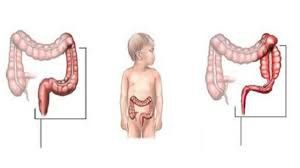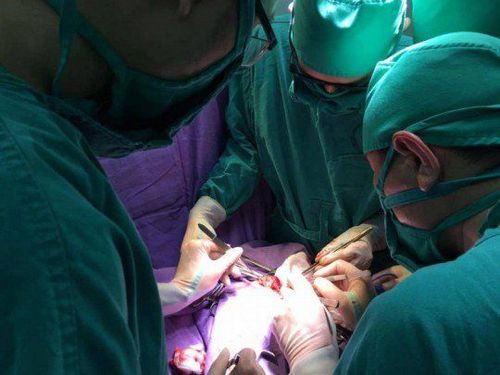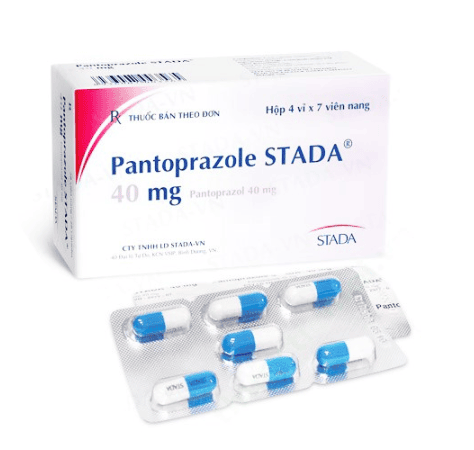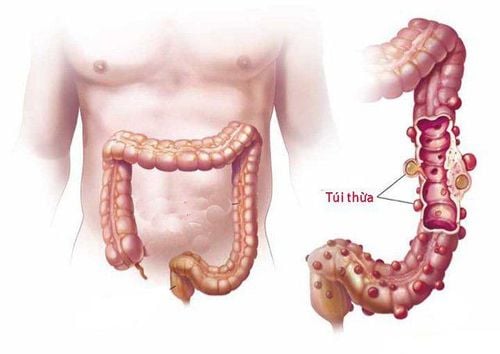This is an automatically translated article.
Congenital megacolon is a birth defect in which nerve cells are missing in a child's colon. Some cases will require surgical intervention and procedures. Laparoscopic surgery for congenital colonic aneurysm is a method to help recover quickly and bring high efficiency.1. What is congenital megacolon?
Congenital megacolon is a birth defect in which nerve cells are missing at the end of a child's intestines. Normally, the intestines contain many nerve cells along its length that control how the intestines function. When the gut is missing nerve cells, it doesn't work as well. This damage causes a blockage in the intestine because stool does not move through the intestines normally.
Usually, the areas that lack neurons are the rectum and sigmoid colon. However, some children have a lack of nerve cells for the entire colon or part of the small intestine.
In congenital short-lived megacolon, nerve cells are missing from the last part of the large intestine. In congenital long-standing megacolon, nerve cells are missing from most or all of the large intestine and sometimes the last part of the small intestine. Rarely, neurons are missing in the entire large and small intestine.
In a child with congenital megacolon, stool moves through the intestine until it reaches the part where the nerve cells are missing. At that time, the stool movement slows down or stops.

Bệnh phình đại tràng bẩm sinh có ở ruột của trẻ
2. Causes of congenital megacolon in children?
During the baby's early development in the womb, nerve cells stop growing towards the end of the baby's intestines causing congenital megacolon. Most of these cells start at the beginning of the intestine and grow towards the end.Congenital megacolon occurs when these cells do not reach the end of the child's intestines. Scientists know that genetic defects can increase the likelihood of congenital megacolon in children. However, there is no test that can diagnose a baby while the mother is pregnant.
3. What are the signs and symptoms of congenital megacolon?
The main signs and symptoms of congenital megacolon are constipation or bowel obstruction, which usually appears soon after birth. Many otherwise healthy infants and children have difficulty passing stools or infrequent bowel movements.However, unlike healthy children and infants, children with congenital megacolon usually do not respond to oral medications for constipation. Usually, an infant or child with congenital megacolon will have other symptoms, including:
Growth failure Abdominal bloating Unexplained fever Vomiting. Symptoms may vary; however, how they changed was independent of the number of gut neurons that were missing. No matter where in the intestines is missing nerve cells, once stool reaches this area, a blockage will form and the child will develop symptoms.
3.1 Symptoms in infants
An early symptom in some infants is the inability to have a bowel movement for the first time within 48 hours of birth. Other symptoms may include:Green or brown vomit Exploding stools after a doctor inserts his finger into an infant's rectum Abdominal distention Diarrhea, often bloody The doctor examines a newborn baby Birth Symptoms of congenital megacolon in infants, toddlers, and older children can include abdominal distension.

Chướng bụng là một triệu chứng của phình đại tràng bẩm sinh
3.2 Symptoms in Toddlers and Older Children
Symptoms of congenital megacolon in toddlers and older children may include:Inability to pass stools without an enema or suppository. An enema involves draining fluid into a child's anus using a special wash bottle. Suppositories are a pill that is placed in a child's rectum. Distention. Diarrhea, often bloody. Slow growth.
4. Laparoscopic surgery for congenital megacolon in children
Laparoscopic surgery to remove congenital aneurysms is surgery to remove the non-ganglionic bowel in order to restore peristalsis of the gastrointestinal tract. In some cases, patients have only a portion of the damaged bowel removed and only need to reconstruct it in one operation.
However, in severe cases the patient has long non-ganglionic bowel segments that need to be performed in two operations. The first time is to remove and remove the intestines for an ostomy in the flaring wall and the second time is to reconstruct the intestines afterwards.
Sometimes children with congenital megacolon have their intestines removed permanently, especially if a long segment of the intestine is missing nerve cells or the child has repeated enterocolitis. lifelong creation.
Laparoscopic surgery for congenital colonic aneurysm in young children is indicated in all sites of nodularity. The child was given endotracheal anesthesia and was lying supine close to the edge of the operating table. The position of the surgeon stands at the patient's feet and the assistant stands to the right of the surgeon, the instrument stands opposite the surgeon.
Laparoscopy kit uses 4 trocars of which 1 umbilical trocar for the laparoscope, 1 in the right iliac fossa and 1 in the left iliac fossa, one in the abdominal fold outside the right rectus muscle. Inflatable pressure from 8-10 mmHg.
The surgical technique performed colonic biopsies in 2 locations, including one where the colon was small in diameter and the other where the colon was dilated. Creating a window through the sigmoid mesentery. Pair, burn, and cut the mesentery and sigmoid colon toward the rectum. Dissection of the rectum posteriorly through the protrusion, 1cm anteriorly below the peritoneal fold. Pair vertebrae and cut the sigmoid mesentery upwards. Clip and cut the trunk of the sigmoid artery. Then proceed through the anus as the technique of anal surgery

Phẫu thuật phình đại tràng bẩm sinh giúp tái tạo ống tiêu hóa
5. Complications and treatment
5.1. Early complications
Injury to the vagina and urethra during surgery: Sew up the vagina and urethra Intra-abdominal bleeding: Re-operate to check the abdomen and stop bleeding. Tear open the abdominal wall: Re-operate to check the abdomen and sew up the abdominal wall Fistula: Do stoma or redo anastomosis Incision infection: Use antibiotics5.2. Late complications
Incontinence: Training in bowel habits Frequent constipation or enteritis: Medical treatment with antibiotics, digestive enzymes. Rectal-vaginal, rectal-urethral fistula: Surgery to suture the fistula Narrow anastomosis: Dilate the anastomosis or redo the anastomosis Intestinal obstruction: Surgical removal of intestinal adhesions Currently, with the development of medicine, the disease This can be completely cured by laparoscopic surgery for congenital megacolon, which is currently being performed routinely at Vinmec International General Hospital. As a key area of Vinmec Medical system, Pediatrics Department always brings satisfaction to customers and is highly appreciated by industry experts with:Gathering a team of leading pediatricians: including leading experts with high professional qualifications (professors, associate professors, doctorates, masters), experienced, worked at major hospitals such as Bach Mai, 108.. Doctors All are well-trained, professional, with a mind - range, understanding young psychology. Besides domestic pediatricians, the Department of Pediatrics also has the participation of foreign experts (Japan, Singapore, Australia, USA) who are always pioneers in applying the latest and most effective treatment regimens. . Comprehensive services: In the field of Pediatrics, Vinmec provides a series of continuous medical examination and treatment services from Newborn to Pediatric and Vaccine,... according to international standards to help parents take care of their baby's health from birth to childhood. from birth to adulthood Specialized techniques: Vinmec has successfully deployed many specialized techniques to make the treatment of difficult diseases in Pediatrics more effective: neurosurgery - skull surgery, stem cell transplantation. blood in cancer treatment. Professional care: In addition to understanding children's psychology, Vinmec also pays special attention to the children's play space, helping them to have fun and get used to the hospital's environment, cooperate in treatment, improve the efficiency of medical treatment.
Please dial HOTLINE for more information or register for an appointment HERE. Download MyVinmec app to make appointments faster and to manage your bookings easily.













